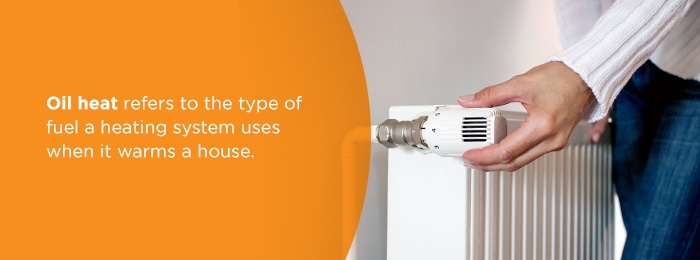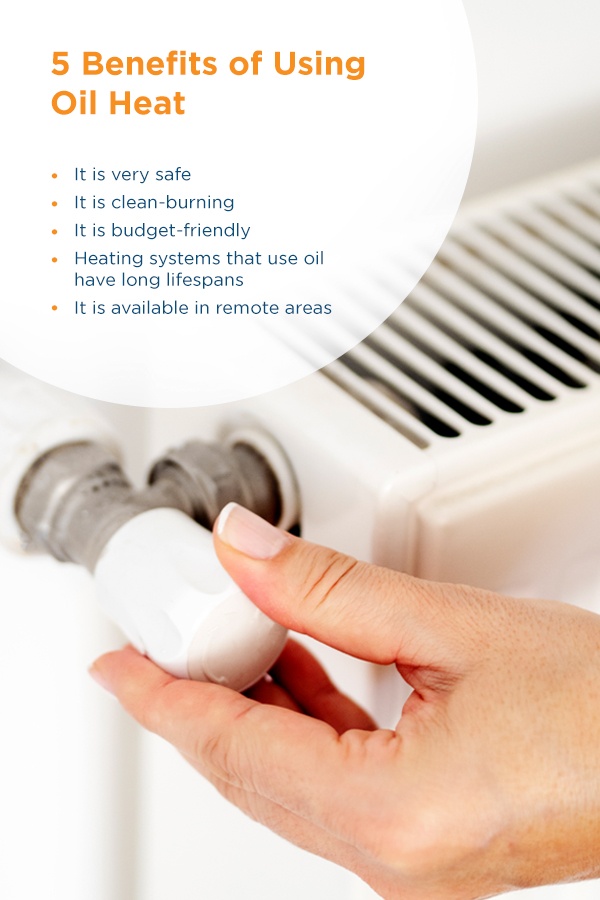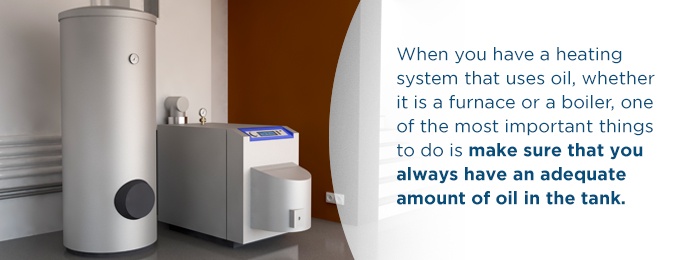How Does Oil Heat My Home?
Across the U.S., just under six million households rely on oil as their source of heat. Although other heating fuel options are available, such as natural gas, propane gas and electricity, some people prefer oil heat. If your home currently uses oil for heating fuel or if you are considering switching to it from another type of heating system, it’s important to understand how oil works and what makes it different from other options. Learn more about the benefits and drawbacks of oil heat, as well as what your options are for using it.
What Is Heating Oil Used For?
Oil heat refers to the type of fuel a heating system uses when it warms a house. Oil heat is often compared to other types of heating fuel, such as natural gas. Although oil was once the fuel of choice for many homes, particularly in the Northeast and Mid-Atlantic areas, natural gas has become more popular in recent years. About 47% of households, or 55 million, in the U.S. use natural gas as their primary source of fuel.

Natural Gas vs. Oil Heat
Heating oil comes from crude oil and is closely related to the diesel fuel that is commonly used to power trucks and other types of vehicles. In the U.S., the oil used as heating fuel comes from a combination of oil refineries located in the country and imports from countries such as Canada. Demand for heating oil rises and falls based on a variety of factors, such as the season. Usually, demand goes up in the winter and falls in the spring. Weather events, such as hurricanes, can also affect the supply of heating oil, leading to an increase in demand.
In contrast, natural gas is a fossil fuel that is extracted from deep beneath the surface of the earth. It is made up of multiple compounds, most notably methane gas. It also contains carbon dioxide, water vapor and hydrocarbon gas liquids. While heating oil comes from a combination of domestic and imported sources, nearly all of the natural gas used in the U.S. also comes from the U.S. In 2018, the U.S. produced 2% more natural gas than it consumed.
There is a difference between the way natural gas and oil reach a home. If your home uses heating oil, you have a tank located somewhere on your property, such as in your backyard or basement. The tank holds the oil you use to heat your home. As the oil supply decreases, the tank needs to be refilled.
People do not keep tanks of natural gas on their properties. Instead, the gas reaches their homes through a series of gas lines. If you want to use natural gas to heat your home, you need to live near a gas line or have the option of having a gas line installed on your property. In Maryland, natural gas lines are only available in certain parts of the state. As long as you can get an oil tank on your property, heating oil can be delivered just about anywhere.
How Does Oil Heat Work?
A heating system that uses oil for fuel relies on several different components to properly heat a home. The components that are often part of an oil-fueled heating system are:
- Oil tank: The oil tank stores the oil until it needs to be used by the heating system. Oil tanks are available in a variety of sizes and shapes, including horizontal and vertical tanks. They might be located above or underground.
- Filter: The filter removes sediment and debris from the oil as it flows from the tank to the heating system.
- Fuel pump: The fuel pump controls the movement of the oil from the tank to the heating system.
- Combustion chamber: The combustion chamber is where the oil is ignited, so that it can warm either water or air, depending on the type of system in place.
- Thermostat: The thermostat measures the temperature in a particular area of a house. When the temperature falls below the set level, the thermostat triggers the heating system to kick on.
When an oil heating system gets the signal that it needs to warm up a house, the oil gets pumped from the tank into the combustion chamber. Usually, the oil is under a lot of pressure as it enters the chamber. Once in the combustion chamber, the oil is lit on fire. Although older oil heat systems featured a pilot light that was burned continually, newer models feature electronic ignition. A flame is only lit when the heating system is running through a cycle.
The burning oil itself doesn’t leave the combustion chamber. Instead, the heat from the burning oil travels into a circulator or heat exchanger. There, the heat comes into contact with either air or water depending on the type of system. Systems that use air pull cold air from the house into the heat exchanger. Systems that use water circulate water through the house through a system of pipes. The warmed air travels through ducts to various areas of the house, while the heated water travels through pipes to baseboards or radiators throughout the house. The cooled air or water once again returns to the heat exchanger or circulator to start the process over.
5 Benefits of Using Oil Heat
If you are considering switching to oil heat or are contemplating buying a house that uses oil as its primary source of heating fuel, you will be happy to hear that oil has several benefits as a source of heating fuel. Some of the benefits of oil heat are:
- It is very safe: Oil is one of the safest heating fuels available as it will only ignite when it is in the combustion chamber of your furnace or boiler. It needs to reach a high temperature (over 500 degrees) and to be under high pressure before it ignites. You can drop a lit match into a bucket of heating oil, and all that will happen is the match will extinguish.
- It is clean-burning: The heating oil used today is designed to be clean-burning. In most states, the only type of heating oil now in use is ultra-low sulfur heating oil, meaning it has a sulfur content below 15 parts per million.
- It is budget-friendly: When you use heating oil in your home, you get a certain amount delivered all at once. SMO Energy gives you the option of signing up for a SmartPay program, which divides up the cost of heating oil, your tank lease and any service agreements you have with us into monthly payments. You can get better control over your budget and avoid surprise energy bills during the winter months using our payment plans.
- Heating systems that use oil have long lifespans: Another benefit of using oil to heat your home is that furnaces and boilers that use oil as their fuel source tend to have longer lifespans than other types of heating systems. Your oil-burning furnace may stay in good working condition for up to 15 to 20 years with preventative maintenance and regular tune-ups. However, like all heating systems, they start to lose efficiency over time and become more expensive to operate as they get older. We recommend replacing any heating equipment in your home every 15 to 20 years.
- It is available in remote areas: Unlike fuels like natural gas where the supply is limited to the location of the gas lines, oil heat is available just about anywhere. Oil heat is an excellent option as long as you have room on your property for an oil tank and can provide access to a delivery driver to reach the tank to fill it up.

Drawbacks of Using Oil Heat
Like all heating options, oil heat is not without its disadvantages. Some of the drawbacks to consider if you are contemplating a switch to oil heat include:
- The cost of oil: Home oil prices can fluctuate based on supply and demand. The average price of oil at the end of January 2020 was about $3.00 per gallon. One year earlier, the average price was about $3.20 per gallon. While a budget-payment plan can help you balance out the cost of oil over a 12-month period, it cannot make up for changes in the price that occur as a result of a drop in supply or an increase in demand from year to year.
- Your tank can dry out: Your oil tank will not replenish itself. If it runs out, your entire heating system can shut down, leaving you without heat until you get a new delivery. There are things you can do to minimize the risk of running out of oil, though. One option is to sign up for automatic delivery service. With automatic delivery, SMO Energy monitors the level of oil in your tank and will make a delivery when it falls below a certain amount. You can also set up scheduled delivery, meaning a new supply of oil will arrive on a regular basis, based on your past usage pattern.
- You need a place to keep your tank: One last drawback of oil heat is that you need to have a spot on your property for the oil tank. Depending on the size of your property and the size of your tank, it might be a tight fit. Some people also find that oil tanks are not particularly attractive. There are ways to cope, though. You can choose a smaller tank if space is limited. You can also position the tank so that it is out of sight. Tanks can even be installed in your basement instead of outside. Just make sure that a delivery driver can easily access it at all times to fill it.
Heating Systems That Use Oil
If your home uses oil heat, it likely has either a furnace or boiler as its heating system. The energy efficiency of both types of systems is measured using annual fuel utilization efficiency (AFUE), a comparison between the amount of heat produced by the heating system to the amount of fuel or energy it uses. The most energy-efficient systems have AFUE ratings over 90%. The least energy-efficient systems have ratings under 50%. Although the concepts of a furnace or boiler are similar, there are several key differences between the two.
Furnaces
A furnace provides heat to your home by circulating warm air through ducts. A fan at the base of the furnace pulls cold air from the house into the heat exchanger. In the heat exchanger, the air gets heated by the burning oil. It is then sent back up to the house, through the ducts. The warm air travels into the rooms of your home through vents and registers. As the air cools down, it travels back into the furnace, to repeat the process again.
Boilers
A boiler provides heat to your home by circulating hot water through pipes. Cool water travels into the circulator of the boiler, where it is heated by the burning oil. From there, it travels back through the system pipes up into your home. The heat from the water is released into your home through baseboard heaters, radiators or heating coils in the floorboards.
Check the Oil Level in Your Tank
When you have a heating system that uses oil, whether it is a furnace or a boiler, one of the most important things to do is make sure that you always have an adequate amount of oil in the tank, particularly during the colder months of the year. If you sign up for automatic delivery, SMO Energy will monitor your tank’s oil level for you and send out a delivery driver to fill it up when necessary. If you choose scheduled delivery, you will still want to monitor the oil level in the tank on your own, to keep your oil from running low and to eliminate the need for an emergency oil delivery. Changes in temperature and daily routines can cause your fuel use to fluctuate and your oil supply to run out sooner than usual.

You can check your tank’s oil levels in a couple of ways. One option is to look at the fuel gauge on the tank, which will tell you if it is full, half-full or nearly empty. If the tank does not have a fuel gauge, you can check the level by sticking the tank, which involves threading a long dipstick into the tank to see how deep the oil is. You can use our Heating Oil Tank Chart to see how much fuel is left in your tank. Of course, if you do not feel comfortable sticking the tank yourself or are not sure if the gauge is accurate, you can always call SMO Energy. We will be happy to send one of our trained technicians to check out your heating oil level for you.
Let SMO Energy Manage Your Residential Oil Heat Maintenance Needs
Oil heat helps you maintain a comfortable and cozy home, even when the temperatures fall below freezing. Your home’s heating fuel system will be able to function best for your family when you take the best possible care of it. That means making sure there is always an adequate supply of oil, performing regular maintenance, such as tune-ups, and acting quickly if something goes wrong.
You do not have to worry about handling all of the requirements of your oil heating system on your own, though. SMO Energy is here to help. We offer same-day and next-day delivery*, automatic delivery and annual service agreements to residences in Southern Maryland. Should it come to the point where your furnace or boiler needs repair or replacement, we can take care of that, too.
To learn more about our services, contact us today.’
*No delivery fee applies to all deliveries 125 gallons or more, same-day delivery is applicable to a fee. **Same day and next day delivery service are subject to change based on weather conditions. Unsafe road conditions create an unnecessary risk to SMO drivers and the environment.

